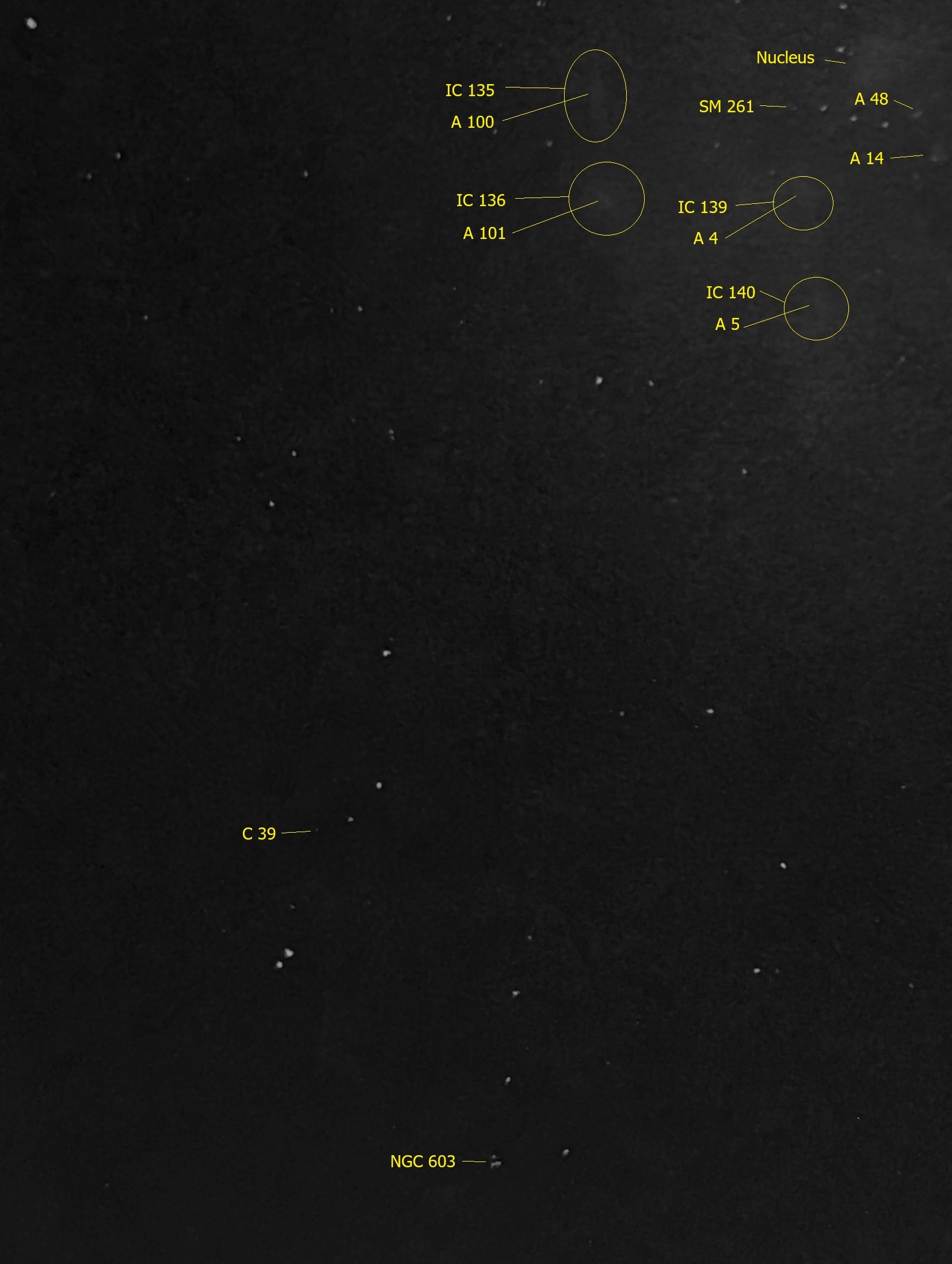M33 and HII Regions - Butch Phaneuf Sketch and writeup
Messier 33 (Triangulum Galaxy) was observed across four nights with a goal of locating as many HII regions, OB associations, and globular clusters as possible. Resources from Tony Flanders, Steve Gottlieb, Howard Banich, Scott Harrington, and Alvin Huey provided essential guidance. The ‘A’ designations follow Roberta Humphreys and Alan Sandage’s catalog of stellar content in M33.
Three sessions focused primarily on HII regions and spiral structure; the fourth session filled in missed OB associations and globular clusters.
M33 and HII Regions — Observing Notes
- GHRO — 10/14, 10/16, 10/20, and 11/11/2025
- Instrument: 24” f/5 DIY Newtonian (FL 3048mm)
- Eyepieces: 21mm Ethos (field), 8mm Ethos @ 381x, 2x TV PowerMate @ 762x
- Conditions: calm, cool, clear; MW well-defined; M31 & Double Cluster naked eye
- Transparency: 10,100 ADU (first 3 nights), 9,700 ADU (4th night)
- Seeing: 2.0 a/sec (first 3 nights), 1.6 a/sec (4th night)
- SQM: 21.1

Observing Summary
The hazy disc filled the 41.4’ field at 145×. The northern arm was identifiable by its chain of HII regions out toward NGC 604, with dusty mottling seen in averted vision. A fainter, second northern arm may have been visible. The southern arms were easier to trace due to brighter IC-designated regions.
The core appeared round, hazy, and broad, with a small nucleus and no sharp brightness cusp — consistent with M33 lacking a supermassive black hole. Stellar arcs traced the northern and southern edges of the core; one “star” later proved to be A48.
NGC Objects
NGC 604
Brightest object in M33. Oval (2.2’ × 1.6’), western edge sharper, faint east side, dark gap through center. Brighter than the core nucleus.
NGC 595
Bright HII region ENE of the core. Elongated NE–SW (1.5’ × 1.2’), brighter center.
NGC 592
Round (1.2’), pair of stars marking the center, brighter interior.
NGC 588
East of 592; similar size but fainter overall.
NGC 603
Catalog error: three stars misidentified as nebulosity. Found via triangle with nearby bright stars. Observed at high mag (381×, 762×).
IC Objects
IC 132
Near HD 9444 at NE edge of disc. Elongated 1.5:1 (PA 0°). Moderately bright in averted vision.
IC 133
4’ × 1’ N–S hazy strand south of the tight double star.
IC 131
Very faint averted-vision patch NW of NGC 595/592.
IC 143
Circular, 2’ glow east of NGC 604; bright center that sometimes flared.
IC 142
Near bright star pair marking inner north arm. Near-stellar bright knot.
Southern-arm IC regions:
- IC 135 - Triangular 5’ × 3’ nebula, mottled with bright knots
- IC 136 - Rounder 5’ nebula, brighter knots southward
- IC 139 - 3’ × 1.5’ N–S mottled region
- IC 140 - 3’ × 1’ elongated region with bright interior knot
- IC 137 - Large 7.5’ × 4’ NE–SW mottled complex extending the southern arm
A-Designated Objects
(Humphreys & Sandage)
A85 / SM 420
Small 0.5’ cluster ESE of the bright star near NGC 604. Young cluster (<10 Myr).
A87
0.6’, faint; forms triangle with A85 and NGC 604.
A90
0.4’, uniform brightness; seen ~40% in averted vision.
A34
2.2’ faint patch in the outer northern arm, marked by nearby star pair.
A66
~0.5’ smudge south of the IC 142 star pair.
A71
Small, bright dot 1’ NW of IC 143.
Bright knots within IC regions:
- A100 - Bright knot in IC 135 (1.5’ × 1’)
- A101 - 2.5’ × 1’ E–W knot in IC 136
- A4 - Bright center of IC 139
- A5 - Bright center of IC 140
- A10 - Bright knot at NNE of IC 137 (2.2’)
Western and southern A-regions:
- A131 - 2.5’ × 1.2’ faint spot with central line
- A21 - 5’ × 5’ mottled haze east of A131
- A127 - Bright elongated 5’ × 1.8’ “tadpole” shape
- A128 - Very faint 1.5’ spot NW of A127
- A115 - Very faint 1.2’ patch S of A127
- A116 - 2.2’ elliptical haze with bright center
- A112 - 4’ × 1.5’ faint haze overwhelmed by HD 9483 glare
- A48 - One of the “stars” in the southern core arc; nonstellar at 762×
- A14 - Faint 0.5’ dot forming triangle with A48 and IC 137
Final-night objects:
- A28 - 1’ patch forming parallelogram with NGC 595, 592, 588
- A17 - Very faint glow S of NGC 592
- A110 / A110A - Barely discernible glow + stellar component after drifting HD 9483 out of frame
B-Designated Stars
- B416 - Probable LBV or binary; mag 16.1; winking appearance
- B324 - Hypergiant; 14.9 mag; central bright spot in IC 142
Globular Clusters
C39
Tiny 0.1’–0.05’ cluster located via bright star pair to the NW.
U49
Old GC; seen as unresolved vertex of right triangle with two bright stars.
SM 261
Young GC; popped repeatedly near chain of three stars on core’s edge.
Closing Thoughts
45 objects were observed - far more than expected - across HII regions, OB associations, globular clusters, and at least two M33 member stars. The project felt like a cosmic Easter egg hunt: an endless, delightful search.
Sketching Notes
White pastel pencils and powder on Canson 92 lb black multimedia paper. IC and A objects are exaggerated to show their relative brightness at higher magnifications.





